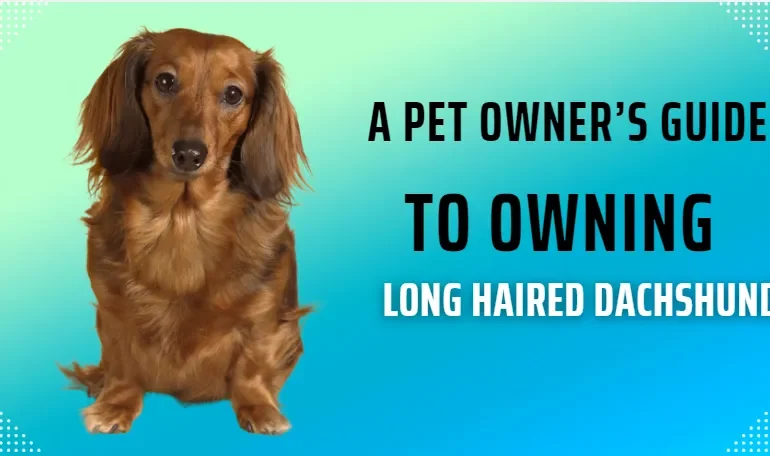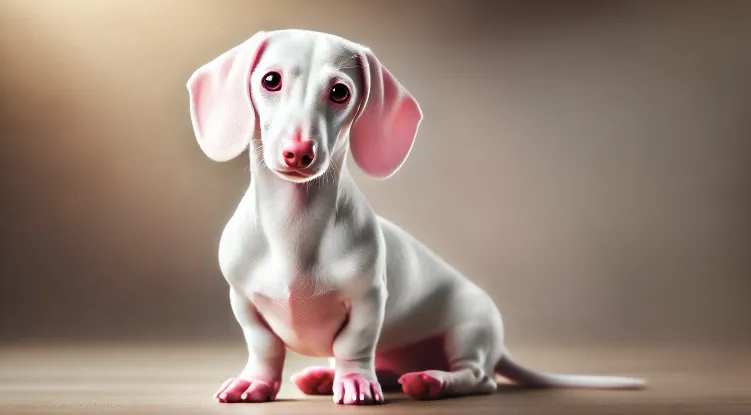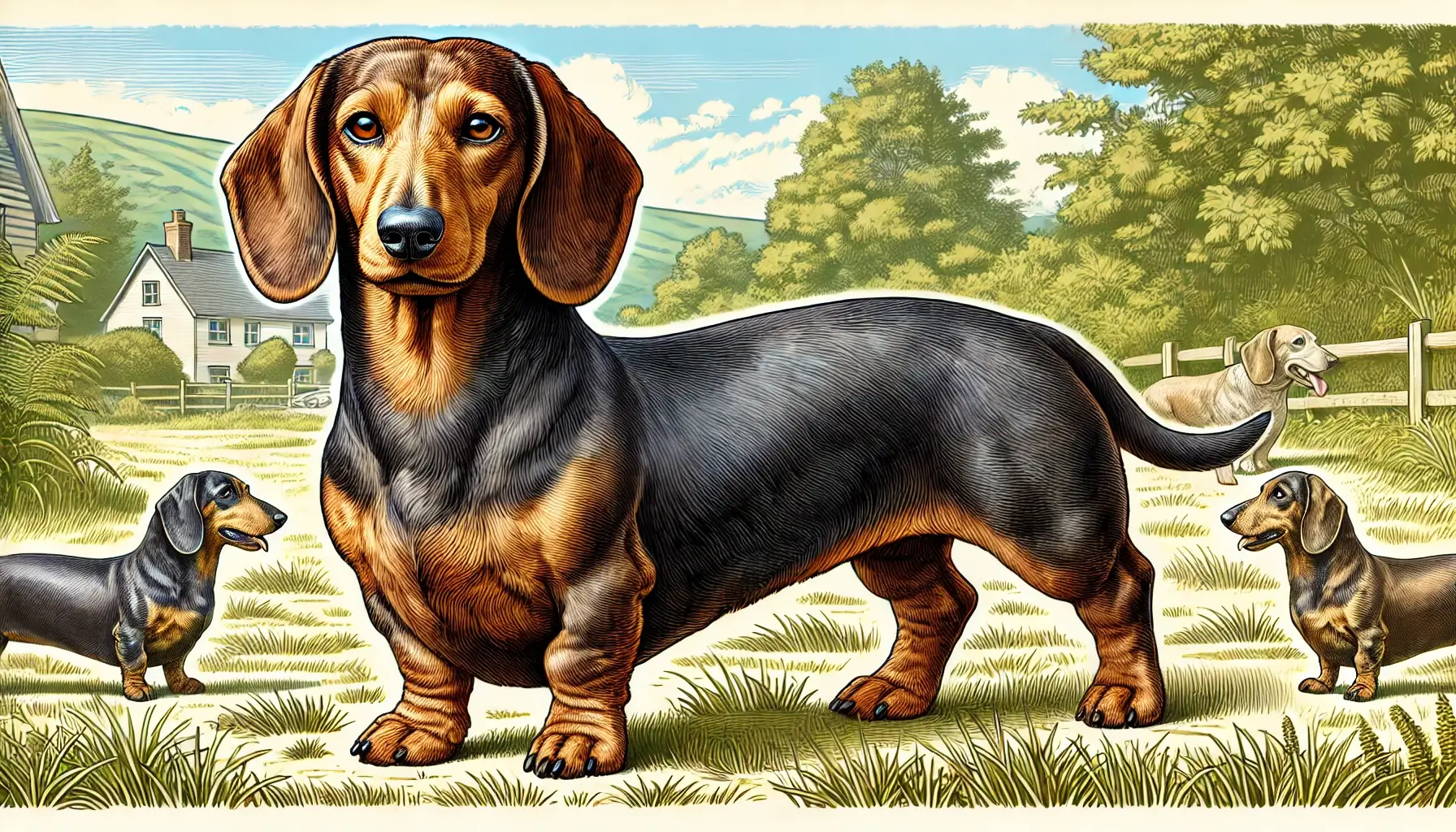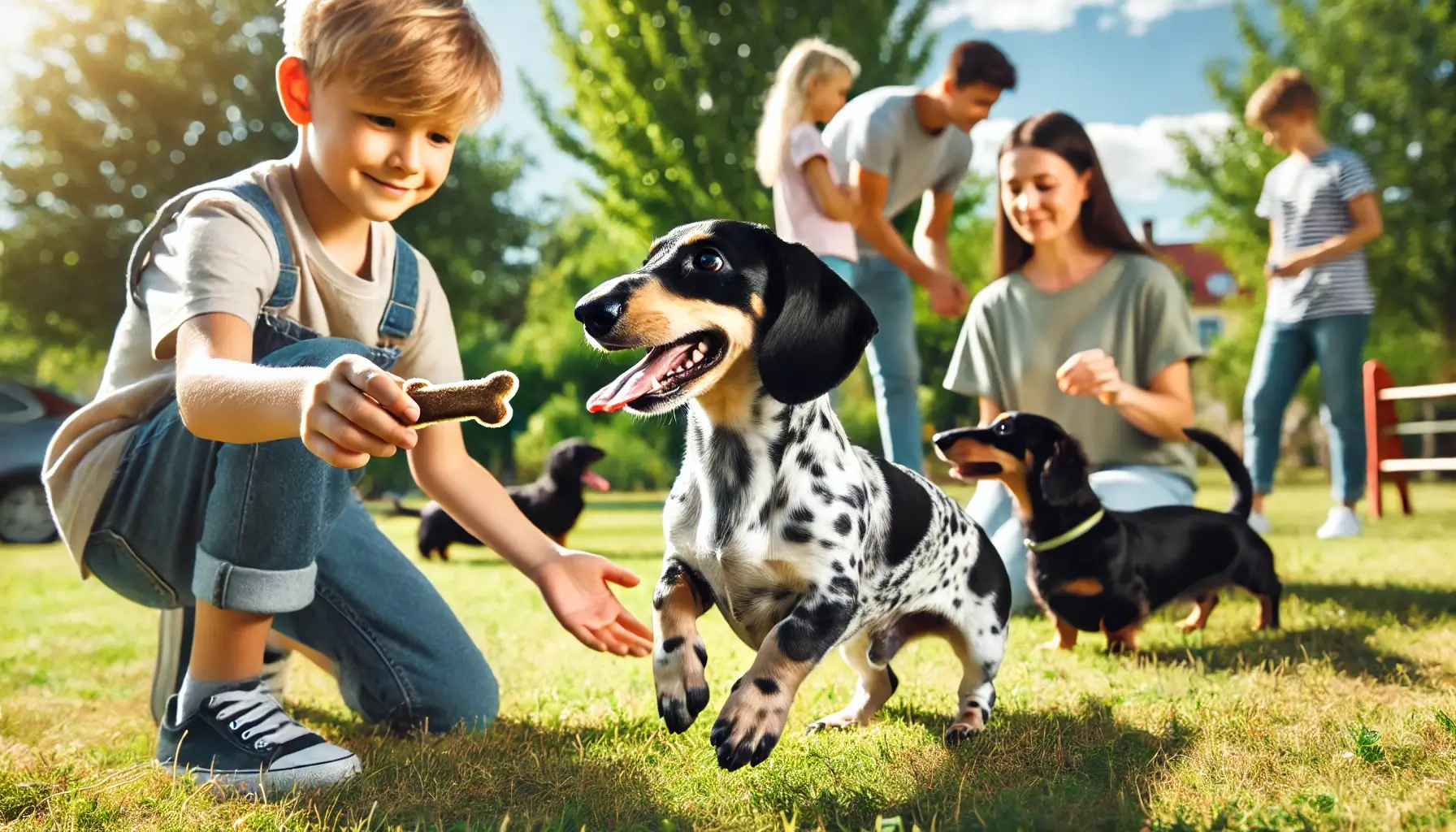
Miniature Dachshund: Doxie Breed Characteristics, Care, and Grooming
My friend and I had a very good debate on the best breed of Dachshunds. He said that a Miniature Dachshund was easier to pet, as he had one, and I was leaning towards a Standard Dachshund, as most people prefer to own them.
But, the popular option is not always the best. That gave me the idea to write an in-depth guide for people confused about whether to buy a dachsund miniature or a standard dachshund.
The comprehensive guide will revolve around some of the basic questions like, how big do mini dachshunds get, how much do miniature dachshunds weigh, what is the mini dachshund life expectancy, and many more.
But, first, let’s get started with the basics.
Miniature Dachshund: What is it?
Let’s start with the basics. For those unfamiliar with the Miniature Dachshund, this small but spirited breed is a shorter and lighter variation of the standard Dachshund.
“The Miniature Dachshunds typically weigh under 11 pounds and stand about 5-6 inches tall. They are known for their long, low bodies and iconic floppy ears, and come in a variety of colors and coat types, including smooth, long-haired, and wire-haired.”
Miniature Dachshunds are celebrated for their bold personality and loyalty, making them wonderful companions in a compact size that’s perfect for both urban and rural living.
What is the History of Miniature Dachshund?
The Miniature Dachshund, like the Standard Dachshund, originated in Germany and was originally bred for hunting purposes. Dachshunds have been around since at least the 15th century, designed specifically to hunt small games such as badgers.
Initially, Standard Dachshunds were more common, but Miniature Dachshunds were later developed for hunting smaller animals like rabbits and vermin. By the late 19th century, both varieties became popular as pets and show dogs in Europe and the United States.
How is a Miniature Dachshund Different from a Standard Dachshund?
Miniature and Standard Dachshunds are distinct in terms of size, not phases of growth. They are genetically different, with Miniature Dachshunds bred specifically to be smaller, weighing less than 11 pounds, while Standards are larger.
Miniature Dachshunds do not grow into Standard Dachshunds; they remain distinct sizes due to selective breeding for their specific traits and purposes.
What are the Characteristics of a Miniature Dachshund?
Now, let’s discuss the characteristics of a Miniature Dachshund. I’m going to break it down by listing the specific traits you can expect to find in this charming breed. Here’s what we’ll be covering:
No. 1: Size and Weight
How much should a mini dachshund weigh? Miniature Dachshunds are compact, typically weighing under 11 pounds (about 5 kg) and standing between 5 and 6 inches tall (around 12-15 cm).
Their small size makes them perfect for both city and rural living, fitting comfortably in small homes or apartments.
Dachshund Size Chart (Mini Dachshund Measurements)
| Size | Weight | Height | Description |
| Miniature Dachshund | Under 11 pounds (5 kg) | 5-6 inches (12-15 cm) | Compact, ideal for smaller spaces, bred for hunting small prey. |
| Standard Dachshund | 16-32 pounds (7-15 kg) | 8-9 inches (20-23 cm) | Larger size, traditionally bred for hunting badgers and larger game. |
Special Note for Size Chart:
- Tweenies: A less common size referred to as “Tweenies” falls between Miniature and Standard sizes, typically around 11-16 pounds. Although this isn’t an official classification by the AKC, some breeders use it to describe Dachshunds of this size.
- Puppy Growth: Dachshund puppies can generally be classified early on as Miniature or Standard based on their growth trajectory, with Miniatures typically reaching their adult size by 12 months and Standards by 18 months.
No. 2: Body Structure
One of the most distinctive features of the Miniature Dachshund is its elongated body paired with short, muscular legs.
This body type, known as “long and low,” was developed to help them navigate tight spaces while hunting small animals.
Their deep chest and strong forearms give them the strength to dig, while their curved tail helps hunters locate them in burrows.
No. 3: Coat Types and Colors
Miniature Dachshunds come in three coat varieties: smooth, long-haired, and wire-haired. Each coat type has its own grooming needs and distinct look.
They also come in a wide range of colors and patterns, from solid black or red to dappled or brindle. This variety adds to their unique appeal, with smooth-coated Dachshunds often needing less grooming, while long-haired ones have a soft, flowing coat.
No. 4: Lifespan and Health
What is the miniature dachshund lifespan? Miniature Dachshunds typically live between 12 and 16 years. They’re known for being a relatively healthy breed, but they are prone to specific health issues, particularly related to their backs due to their long spinal structure. It’s important to take preventive measures, like limiting high jumps and using ramps when possible.
Miniature Dachshund Temperament and Personality
Let’s explore the unique traits that make Miniature Dachshunds so popular especially among the U.S and European people.
As I have repeatedly said, Miniature Doxen are known for their hunting nature, and most importantly, for their stubbornness.
But, they are more than just regular doxen doggies: Here are some questions that might naturally come to mind as you question regarding their temperament.
Are Miniature Dachshunds Really as Loyal as People Say?
Miniature Dachshunds are famously loyal to their families and can become very attached to a specific If you work from home or have a flexible schedule, you’ll find this loyalty a rewarding trait. However, for families where everyone is gone for long hours, separation anxiety might become a challenge.
Why Are Miniature Dachshunds Known for Their Stubbornness?
These dogs are independent thinkers, which can sometimes be mistaken for stubbornness. They were originally bred to hunt independently, and this trait remains strong.
Patience and consistency are key, and using positive reinforcement techniques can make training smoother. This strong-willed trait may test your patience, but it also showcases their unique character.
How Much Exercise and Play Do Miniature Dachshunds Need?
Miniature Dachshunds are active little dogs, despite their small size, and need daily exercise to stay healthy. They enjoy walks, playtime, and even digging activities.
This high energy level helps keep them mentally stimulated, but if they don’t get enough exercise, they may turn to behaviors like excessive barking or chewing to burn off energy. What can you do? You can plan for at least 30 minutes to an hour of activity each day to keep them happy and content.
Do Miniature Dachshunds Make Good Watchdogs?
Yes, they do! Miniature Dachshunds have a strong protective instinct and will often alert their owners to any unfamiliar noises or visitors. This makes them surprisingly effective watchdogs for their size. However, some owners have mentioned that this trait can lead to excessive barking if not properly managed.
For example, a user on a pet forum shared that their Miniature Dachshund barks at anything passing by the window, making training essential to avoid annoying the neighbors. With consistent training, you can reduce unnecessary barking while still benefiting from their alert nature.
No. 5: How Do They Get Along with Other Pets and Children?
Miniature Dachshunds are generally good with children and other pets if they’re socialized from a young age. Their high prey drive can make them a little reactive to smaller animals, but many owners have shared positive experiences of their Dachshunds living harmoniously with other pets.
For example, one Quora user shared that their Dachshund is great with the family cat, though introductions were slow and supervised. With children, they do best with older kids who understand how to be gentle, as their small size and long backs make them prone to injuries if roughly handled.
Care And Grooming Guide Of A Mini Doxie
Miniature Dachshunds, like their Standard counterparts, come in three distinct coat types: smooth, long-haired, and wire-haired. Each type has unique grooming needs to keep your Mini Doxie looking and feeling their best. Here’s how to care for each coat type:
1. Smooth Coat
The smooth-coated Miniature Dachshund has short, shiny fur that lies close to the body. This coat type is the easiest to maintain, as it doesn’t require a lot of grooming.
Grooming Tips:
- Brush once a week using a soft-bristle brush or a grooming mitt to remove loose hairs and keep their coat sleek.
- Bathing once a month or as needed will keep them clean. Smooth coats don’t trap much dirt, so frequent baths are not necessary.
- Wipe their coat occasionally with a damp cloth to remove dust and maintain shine.
2. Long-Haired Coat
Long-haired Miniature Dachshunds have a soft, flowing coat that’s slightly wavy. This type requires more maintenance to prevent tangling and matting.
Grooming Tips:
- Brush their coat a few times a week with a slicker brush to remove tangles and mats, particularly around the ears, chest, and legs, where hair is longer.
- Use a detangling spray if necessary to make brushing easier.
- Bathe them once every 4-6 weeks, and use a conditioner specifically designed for dogs with longer coats to keep it smooth and manageable.
- Trim excess hair around the paws and under the belly to keep them tidy and prevent dirt buildup.
3. Wire-Haired Coat
The wire-haired Miniature Dachshund has a dense, coarse topcoat with a soft undercoat, giving them a rugged appearance. Their grooming routine is the most involved among the three types.
Grooming Tips:
- Brush their coat weekly with a slicker brush to keep the outer layer neat and remove loose hair.
- Hand-stripping, a technique to remove dead hair from the undercoat, should be done several times a year to maintain their coat texture. This can be done by a professional groomer if you’re unfamiliar with the process.
- Trim around the beard, eyebrows, and paws to maintain a clean look.
- Bathe them as needed, typically every 6-8 weeks, but avoid over-bathing, as it can strip natural oils from their coat.
Regardless of coat type, all Miniature Dachshunds benefit from regular nail trimming, ear cleaning, and dental care. Proper grooming not only keeps their coats looking great but also contributes to their overall health and comfort.
What Does a Miniature Dotson Dog Eat? (Nutrition Guide)
If you’re wondering what to feed your Miniature Dachshund, Miniature Dotson, or small wiener dog, you’re not alone! Nutrition plays a huge role in keeping these little guys healthy, active, and at their best weight. Here is a nutrition guide you can follow to ensure your doxie remains healthy.
Use Protein for Strong Muscles
Protein should be the primary ingredient in your Miniature Dachshund’s diet. Since they’re small but quite active, their meals should include high-quality sources like chicken, beef, fish, or lamb.
Look for dog foods with around 18-22% protein content, as this helps build and repair muscles, especially since Mini Dachshunds love to be on the move!
2. Healthy Fats for Skin and Coat
Miniature Dachshunds benefit from healthy fats, which help maintain their shiny coats and support brain health.
Look for foods with omega-3 and omega-6 fatty acids from sources like fish oil, flaxseed, or chicken fat. While fats are essential, be mindful of portion sizes—since Mini Dachshunds are prone to obesity, it’s important to keep their diet well-balanced.
3. Carbohydrates for Energy
While adult mini dachshund don’t require a lot of carbohydrates, a small amount can provide energy, especially if they’re zooming around the yard or taking daily walks. Opt for complex carbs like sweet potatoes, brown rice, or oats. Avoid fillers like corn and wheat, as these can sometimes lead to allergies and don’t offer as many nutritional benefits.
One pet parent on Quora mentioned that their small wiener dog had fewer digestive issues after switching to a grain-free kibble with sweet potatoes as the primary carb source.
4. Vitamins and Minerals
A balanced diet for a full grown mini dachshund should also include essential vitamins and minerals. Calcium and phosphorus are important for bone health, especially with their long spines, which are prone to injury.
Vitamin E and zinc help support a healthy immune system and skin. You can either choose high-quality dog foods that meet these requirements or consult with a vet to determine if supplements are needed.
5. Portion Control and Feeding Schedule
Because of their small size, portion control is key to preventing weight gain. Miniature Dachshunds typically thrive on two small meals a day.
An adult miniature dachshund usually needs about ½ to 1 cup of dry food per day, divided into two meals. Treats should be given sparingly and ideally used for training rather than in excess, as they can quickly add calories.
When to Neuter Your Mini Dachshund?
Neutering a Miniature Dachshund at five months can be common, but some vets and Dachshund owners recommend waiting a bit longer. Many suggest neutering closer to 8-12 months, especially for this breed, as it allows their bones and joints to develop more fully.
I found a thread on Reddit where a debate sparked when a user said that they waited until eight months when their Dachshund started showing humping behavior, which neutering significantly reduced.
Some studies indicate that delaying neutering may reduce the risk of certain conditions, such as intervertebral disc disease (IVDD), which Dachshunds are prone to.
Frequently Asked Questions (FAQs)
Is a Miniature Dachshund a good pet?
Yes, Miniature Dachshunds make wonderful pets! They are loyal, affectionate, and great companions, though they can be a bit stubborn and independent.
What are the cons of a Miniature Dachshund?
Some cons include their tendency for back problems, excessive barking, and a strong prey drive, which can make them challenging with small animals.
Are Miniature Dachshunds difficult?
Miniature Dachshunds can be challenging due to their independent nature, but with consistent training and patience, they’re very rewarding pets.
Do Mini Dachshunds bark a lot?
Yes, Mini Dachshunds are known for being vocal, often barking at strangers, other animals, or anything they find unusual, making them effective watchdogs.
When Do Dachshunds Stop Growing?
Miniature Dachshunds typically reach their full adult size by around 12 months, while Standard Dachshunds may continue to grow until 18 months.
Conclusion: Miniature Dachshund
Miniature Dachshunds weigh under 11 pounds and stand only about 5-6 inches tall. These small wiener dogs pack a big personality into a small frame.
Their grooming needs vary depending on coat type, whether smooth, long-haired, or wire-haired, but each one just adds to the charm of this breed. With a bold temperament, Miniature Dachshunds are known for their loyalty, occasional stubbornness, and strong watchdog instincts—always ready to alert you of anything unusual.
So, if you’re looking for a companion who’s equal parts spunky and affectionate, a Miniature Dachshund might just be your perfect match.





